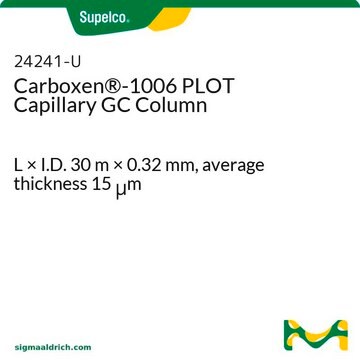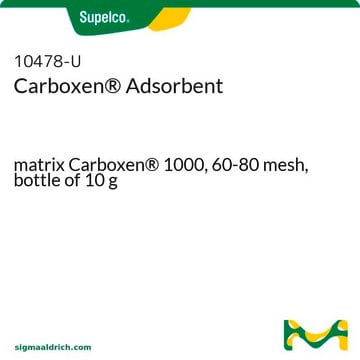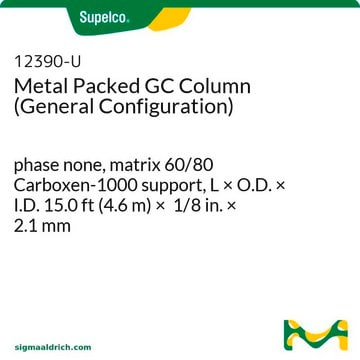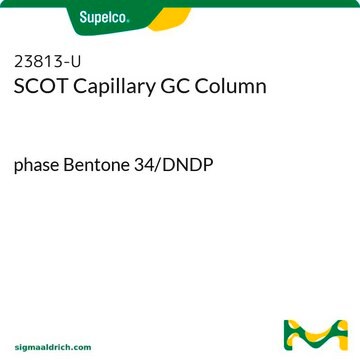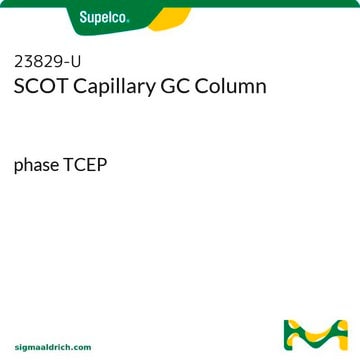If this product has an expiration or retest date, it will be shown on the Certificate of Analysis (COA, CofA). If there is no retest or expiration date listed on the product's COA, we do not have suitable stability data to determine a shelf life. For these products, the only date on the COA will be the release date; a retest, expiration, or use-by-date will not be displayed.
For all products, we recommend handling per defined conditions as printed in our product literature and website product descriptions. We recommend that products should be routinely inspected by customers to ensure they perform as expected.
For products without retest or expiration dates, our standard warranty of 1 year from the date of shipment is applicable.
For more information, please refer to the Product Dating Information document: https://www.sigmaaldrich.com/deepweb/assets/sigmaaldrich/marketing/global/documents/449/386/product-dating-information-mk.pdf
25467
Carboxen®-1010 PLOT Capillary GC Column
L × I.D. 30 m × 0.53 mm, average thickness 30 μm
Sinônimo(s):
Carboxen® 1010 PLOT Column, 30m x 0.53mm
About This Item
Produtos recomendados
Materiais
fused silica
Agency
ASTM® D3612-96
descrição
PLOT = Porous Layer Open Tubular
fabricante/nome comercial
Carboxen®
Parâmetros
≤25-250 °C temperature (isothermal or programmed)
espessura média
30 μm
df
30 μm
técnica(s)
gas chromatography (GC): suitable
C × D.I.
30 m × 0.53 mm
Grupo ativo da matriz
Carbon molecular sieve phase
aplicação(ões)
chemicals and industrial polymers
food and beverages
tipo de coluna
capillary PLOT
Procurando produtos similares? Visita Guia de comparação de produtos
Categorias relacionadas
Descrição geral
USP Code: None
Phase:
- Carbon molecular sieve
- Subambient to 250 °C (isothermal or programmed)
Outras notas
Informações legais
Aplicação
Escolha uma das versões mais recentes:
Já possui este produto?
Encontre a documentação dos produtos que você adquiriu recentemente na biblioteca de documentos.
Os clientes também visualizaram
-
How can I determine the shelf life / expiration / retest date of this product?
1 answer-
Helpful?
-
-
How is shipping temperature determined? And how is it related to the product storage temperature?
1 answer-
Products may be shipped at a different temperature than the recommended long-term storage temperature. If the product quality is sensitive to short-term exposure to conditions other than the recommended long-term storage, it will be shipped on wet or dry-ice. If the product quality is NOT affected by short-term exposure to conditions other than the recommended long-term storage, it will be shipped at ambient temperature. As shipping routes are configured for minimum transit times, shipping at ambient temperature helps control shipping costs for our customers. For more information, please refer to the Storage and Transport Conditions document: https://www.sigmaaldrich.com/deepweb/assets/sigmaaldrich/marketing/global/documents/316/622/storage-transport-conditions-mk.pdf
Helpful?
-
-
What are the specific functional groups that may affect the separation and the carbon saturated/unsaturated ratio of the material used in the Carboxen 1010 PLOT capillary column?
1 answer-
The material used in the Carboxen 1010 PLOT capillary column does not retain any functional groups after the synthesis process due to the high temperatures involved. The carbon surface consists mainly of carbon and hydrogen, with very few exceptions.
Helpful?
-
-
Are there specific installation instructions available for the Carboxen-1010 plot column 24246, particularly regarding whether it needs to be baked out before use?
1 answer-
The installation of capillary columns can differ based on the gas chromatography brand, detector type, injection port, and insertion distance. It's advisable to consult the GC manual for column insertion distance information and any special adapters required before installation.
Helpful?
-
-
Is the Carboxen 1010 PLOT column, Product 25467, GC/MS compatible?
1 answer-
Yes, the particles are very strongly adhered to the surface of the column and would be compatible with mass spec detection.
Helpful?
-
-
What is the film thickness of the Carboxen™-1010 PLOT Capillary GC Column, Product 25467?
1 answer-
The film thickness for this column is 30um. The term "film" is somewhat of a misnomer because it is actually a layer of solid carboxen particles adhered to the fused silica tubing.
Helpful?
-
-
How can I purchase a column that is packed with this material?
1 answer-
Most packed column are custom made and require that you obtain a quotation. Please contact our Customer & Sales Services group at phone number (800)-247-6628, fax number (800)-447-3044 or email [email protected] for additional information.
Helpful?
-
-
What types of compounds would be suitable for analysis on the Carboxen™-1010 PLOT Capillary GC Column, Product 25467?
1 answer-
This column is designed for the analysis of permanent gases and light hydrocarbons up to a maximum of 3 carbon units.
Helpful?
-
-
What is the Department of Transportation shipping information for this product?
1 answer-
Transportation information can be found in Section 14 of the product's (M)SDS.To access the shipping information for this material, use the link on the product detail page for the product.
Helpful?
-
Active Filters
Nossa equipe de cientistas tem experiência em todas as áreas de pesquisa, incluindo Life Sciences, ciência de materiais, síntese química, cromatografia, química analítica e muitas outras.
Entre em contato com a assistência técnica

